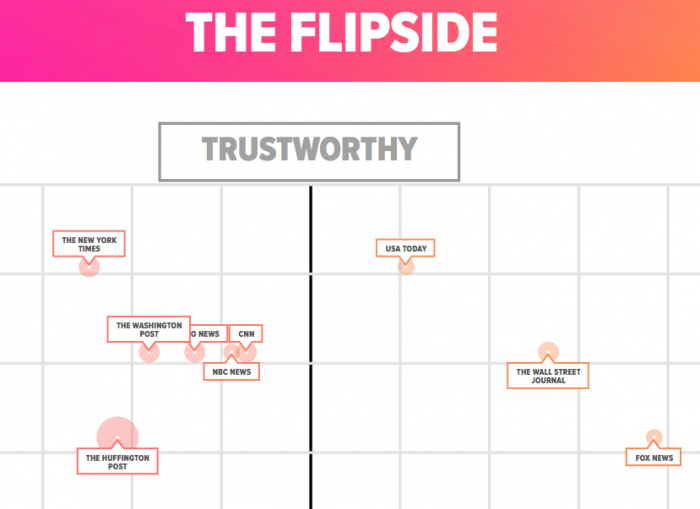
Right now, if you’re one of the small number of people who actually care about exploring the biases in your news consumption, you have to do a little work. You can install a Chrome extension, maybe, or an app. Or you can seek out alternate sources to add to your reading list. One thing these activities have in common is that they’re not much fun.
Analyzing and changing your media diet may never actually be fun, but The Huffington Post is trying to make it at least slightly more so with The Flipside, an interactive matrix that collects the latest headlines on various topics (immigration, Neil Gorsuch’s nomination to the Supreme Court, Russia) from 14 publications and plots them on a grid, from most to least trustworthy and most liberal to most conservative.Julia Beizer, head of product at The Huffington Post, wrote in a blog post Tuesday:
Today, you can dive into the Russia topic and see a mix of stories about this morning’s attack and the Trump team’s connections to the Russian government. But what’s trending across these sources paint a wildly different picture of what matters on this topic. A Daily Kos story is trending on Comey’s impact on the presidential election, while Breitbart’s trending story is on France’s Marine Le Pen encouraging Putin to partner with the West in the face of terrorist threats. Mainstream media, for its part, trends with a mix of news on the attacks and opinion pieces about Trump and Russia.
“We didn’t want to approach this in a really didactic way — like, ‘Here are five news stories you’re not seeing, liberal user,'” Beizer told me. “If you wanted to take a peek at someone else’s feed, this is what you might see. It’s a spectrum of how people cover these really thorny topics; it’s more of a grazing tool.” (And you don’t have to install anything.) The Huffington Post is linking to The Flipside from its homepage and social channels Tuesday, but eventually, the tool will be incorporated into its stories: It might appear at the bottom of a Huffington Post article to show a spectrum of how other news organizations are covering that same topic. (This is somewhat similar to what BuzzFeed is doing with its “Outside Your Bubble” feature.) There are, conceivably, other outlets for such a tool as well: Last month, at a Facebook Journalism Project hackathon in New York, members of The Huffington Post’s product/tech team collaborated with other publishers to create a Flipside-like product for the Facebook platform, which would allow users to see where a piece of news appears on an ideological spectrum without leaving the News Feed. It was the Hackathon’s winning project.
A few notes on methodology: The headlines on The Flipside are culled from the 14 publications’ Twitter feeds over a period of two hours. The Huffington Post didn’t rank the sources itself on either trustworthiness or ideology. The ideological rankings came from a 2016 Public Opinion Quarterly study that used a combination of machine learning and crowdsourcing to plot sources on a spectrum. And for the trustworthiness ratings, they worked with Snopes to categorize the outlets’ trustworthiness. (I asked Snopes for more information and hadn’t heard back at the time of publishing this post.)
When you play around with the tool, you’ll notice that The Huffington Post is included on the grid — and ranked lower in trustworthiness than outlets like The New York Times and The Washington Post. In fact, Snopes gave it the same trustworthiness rating as it gave Fox News.
“Yup. We’re not at the top of the trustworthiness scale,” Beizer said. “But under our new editorial leadership, we are out there every day, trying to earn readers’ trust. That’s why I was really adamant on including ourselves in the scale.”